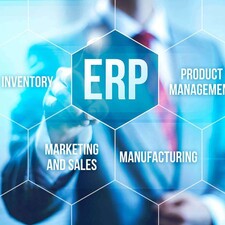Blog
How to develop stronger ERP workflow management

Summary
Business processes and ERP workflow management are the lifeblood of the modern enterprise, but many companies neglect to manage these operational dynamics alongside the data they create, gather and share on a day-to-day basis. When you have an enterprise resource planning system that incorporates business process management tools in place, you can more readily integrate data and workflows to connect employees to the other people and data they rely on every day.
A workflow is a task a user completes in order to meet a specific demand. A process, on the other hand, is a group of interdependent tasks. In most cases, the ideas of managing processes and workflows become somewhat interchangeable because they are so closely related. A company may have a preconfigured workflow for how a user picks an item from a warehouse shelf, for example, but a procurement process that involves having multiple stakeholders analyze data from across different departments. Dedicated business process management solutions enable organizations to map out these tasks, assign responsibilities to different user groups and configure databases to send information to users in line with the work they need to complete.
For more on the future of ERP. Download.... How to Leverage IIoT with Modern ERP

Aligning processes and data
Discrete workflow management software systems and BPM platforms can be effective, but only if they integrate with the ERP solution that underpins the business. The abas ERP platform addresses this challenge with built-in process and workflow management capabilities, letting organizations streamline data and workflows.
ERP workflows allow employees in the field to get notifications if an urgent call comes in
For example, the abas ERP Service Processing module unifies workflows across customer and field services components of the business, allowing your field service teams and customer support agents share data and collaborate to solve problems. Furthermore, the data spreads across workflows so employees in the field get notifications if an urgent call comes in and vice versa.
The abas ERP platform performs a similar function when it comes to our Financial and Accounting system and our integrated Sales Management and CRM tools. By bringing these disparate solutions together, we enable organizations to establish workflows and processes across typical organizational silos, removing many efficiency barriers.
Building for ERP workflow management success
An electronic business suite, such as an ERP system, can go a long way in improving workflow management by providing a connective tissue between people and data. However, finding success with such solutions depends on doing the legwork in the planning stages. Businesses must carefully analyze their own operations in order to map out their processes so they can adjust workflow models in the ERP software. To do this, companies should:
-
Bring together managers from across multiple disciplines to identify the processes completed by different users.
-
Draw out the connections between processes - literally - to understand the chains of events that go on when completing a workflow.
-
Identify and track who is responsible for what at decision points within processes.
With this type of process map in place, you develop a deep enough functional understanding of the organization to align your backend databases, including the ERP, with the tasks being completed on a regular basis.

Standardizing, digitizing and automating
The first step in process and workflow management should be standardization. When you create a workflow, you need users to do it the same way every time and to have any type of exception trigger a different workflow. Your ERP system can then track what is being done to document compliance and ensure quality across all operations.
Furthermore, giving data to users in a convenient way makes it easier for them to follow allow with the existing workflows.
giving data to users in a convenient way makes it easier for them to follow allow with the existing workflows
Standardization alone is only the starting point. Digital transformation is taking hold across just about every sector. With consumers embracing technology and the instant gratification it offers, businesses are being pressured to improve their responsiveness, flexibility and service delivery. This means more than just moving from paper-based systems to electronic ones, and is dependent on integrating processes and information across those digital platforms. An ERP system with built-in workflow management tools makes it much easier to digitally transform and allow users to easily complete workflows without having to jump between multiple disparate systems.
When you've standardized and digitized, you can then move forward to automating. If you have large quantities of historic data integrated across systems and organized into reports and metrics that inform your workflows, you can then set notifications and triggers that enact processes when certain parameters are met. For example, you can set a purchase order to be created and sent to a procurement manager for approval any time a cycle count drops below a certain point, and have the quantities of that order determined based on sales and supply data. From there, the human worker views all the data in one place and completes two tasks - making the decision on a purchase and sending out the purchase order.
Developing stronger ERP workflows begins with tight integration, then extends through careful planning and digitalization to allow for process automation.
Need an ERP system that can manage your complex workflows? Check out our abas ERP overview brochure or contact a representative from abas USA today.


